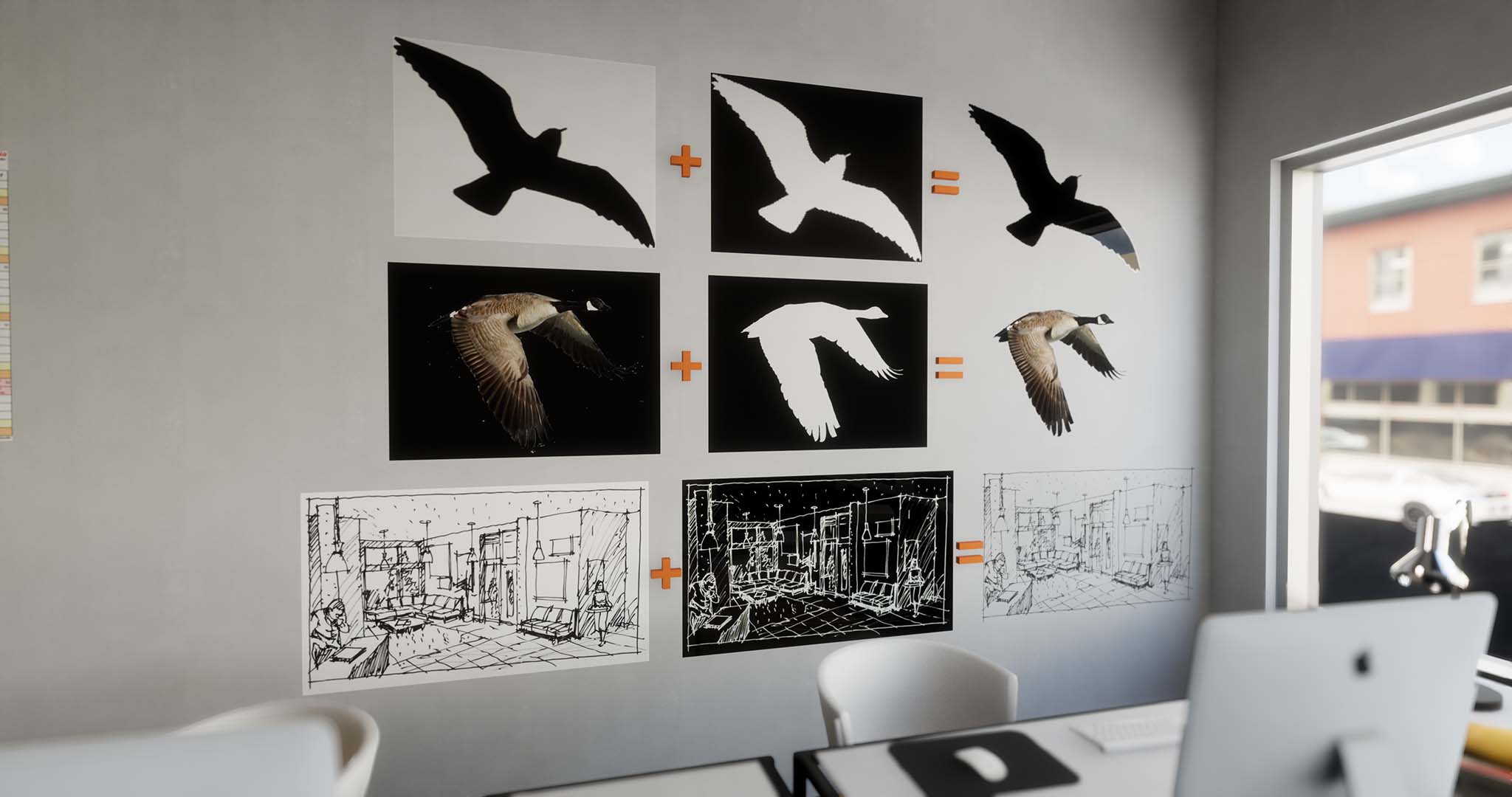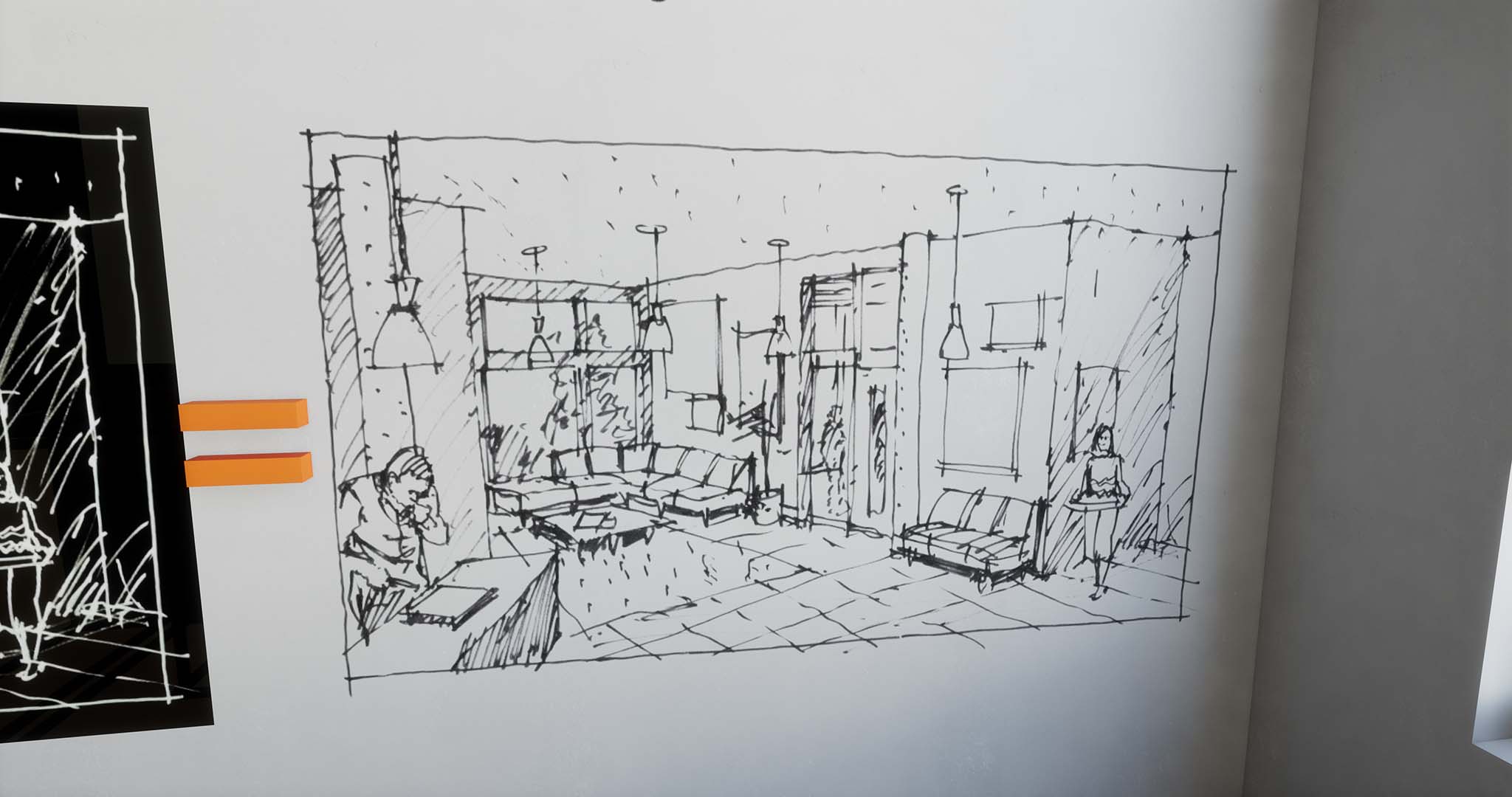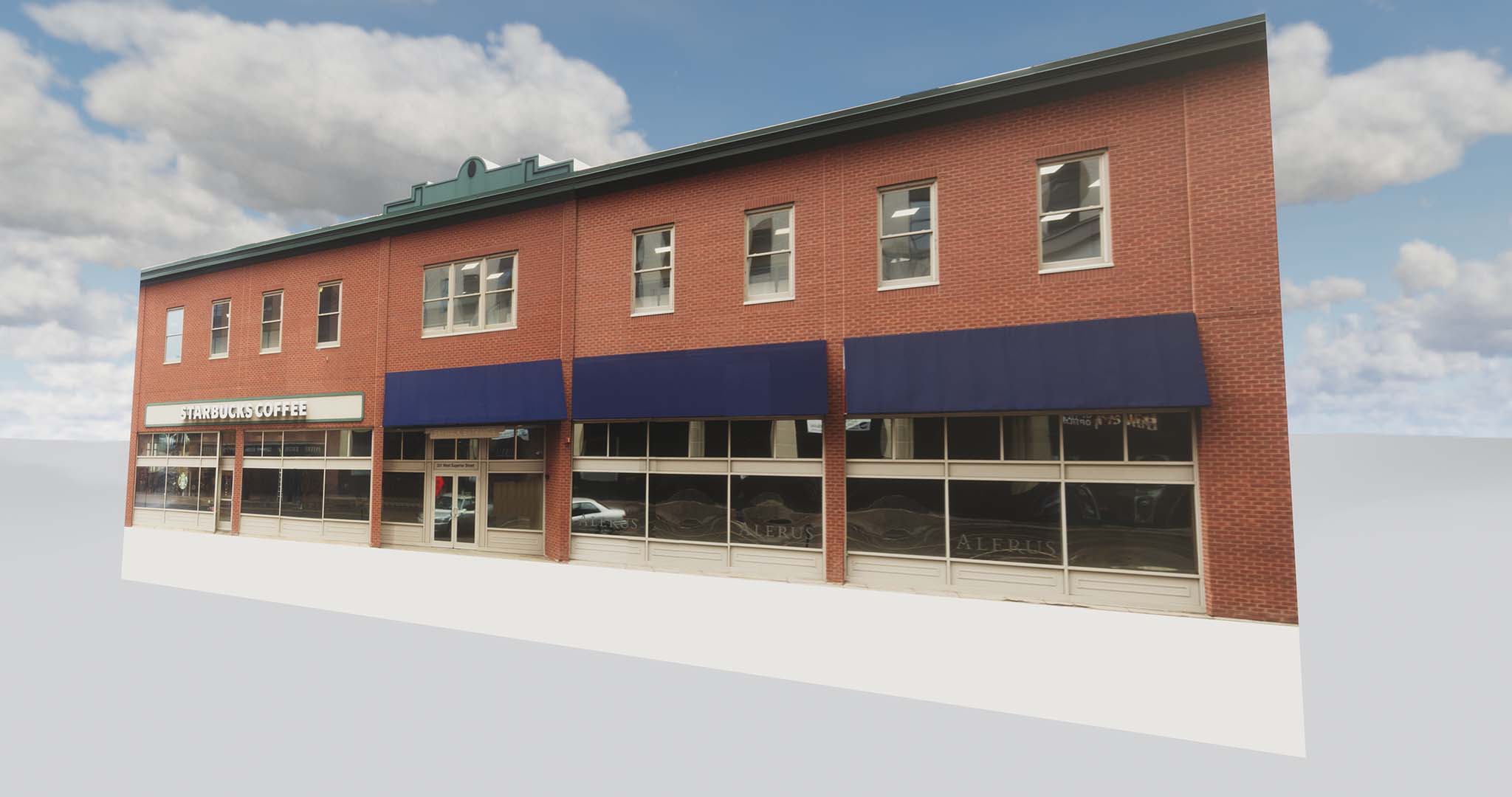Best Practices for using Revit Decals with Enscape
Do you want to make your visualizations more realistic or meaningful to your client?
You may have client specific images, wayfinding graphics or entire adjacent buildings to depict. If you are using Enscape with Autodesk® Revit, then this article will empower you to achieve this effect.
Placing an independent image in Revit is done using the Decal command. This is a great way to present framed art and other embellishments in your renderings. In previous posts we covered ways to use RPC content to embellish your scenes with people, cars, trees and general clutter. Decals are supported in Enscapes Real-Time Rendering environment, including panorama and
Virtual Reality . This article will show several examples of Decals placed in Revit models and how they help to create a more realistic image in Enscape through context and clutter.
The Many Uses for Decals
When LHB was designing its new LEED® CI Platinum office space in Minneapolis, I created several rendered images which included many Decals in Revit. This index can be used with the following images to understand how and where Decals were placed in the Revit model.
- Computer monitors – Each screen has a different image for added realism
- Marketing boards – Firm projects on aluminum panels suspended with aircraft cable in front of glass panels
- Exit Sign – This was added over a linked MEP model element
- Printed project drawing – An image of a print from a real project for added realism
- Television screen – An image from the current lobby graphics at the time
- Sketch pin-ups – Scanned sketches to make the space look “lived in”
Please pay attention to the interactivity of the following graphics in this blog post. For desktop view you can use mouseover and for mobile view you can click on the images to see the annotated Decals.
LHB Minneapolis office relocation project – one; different forms of decals
LHB Minneapolis office relocation project – two; different forms of decals
LHB Minneapolis office relocation project – three; different forms of decals
LHB Minneapolis office relocation project – four; different forms of decals
LHB Minneapolis office relocation project – five; different forms of decals
LHB Minneapolis office relocation project – six; different forms of decals
These images use ArchVision, AXYZ and custom RPC content throughout to create a more lively space. Keep in mind that decals, like Revit materials , are externally referenced material. Thus, the images must stay with the Revit model or they will appear missing when the model is opened.
Decals with Cutouts
Now we will take a look at another Revit model and how it is using decals. In the first image below, notice the posters on the wall, they are decals. Additionally, the vinyl bird graphics on the interior glass wall are also decals. These bird graphics use the decal’s Cutout feature.
This index can be used with the following images to understand how and where Decals were placed in the Revit model.
- Framed Artwork – Each frame has a different image for added realism
- Vinyl Graphics – Used for wayfinding, signage, aesthetic effect
- Transparent Graphic – Special example of transparent decal
- Site Context – Photo of adjacent existing building
Office perspective showing various decals
Here are the settings available in Revit’s Decal Types dialog. The main settings for the wall poster example are the external image to use and the Finish; Matte, Semi-gloss, Gloss, High gloss, custom.

Decal setting for wall posters
The main settings for the vinyl bird graphics are the external image to use, Finish; and another external image to use for the Cutout. In the cutout image, black completely removes areas from the first image and other colors add various levels of transparency to the original image. Note, that any transparency in a PNG file is not used in Revit or Enscape in the context of decals.

Decal setting for bird cutouts
The next image shows the same decals plus a very large one outside the building. This decal uses a photograph of an actual adjacent existing building to provide more realism to the presentation. This Enscape generated image has the Depth of Field value adjusted to slightly blur out the background.
Different perspective on office showing decal of adjacent building
The various effects of the decal’s Finish settings can be seen in this next image. Plus, the white bird is slightly transparent as it uses a cutout with a black outline and a gray center, not white. Also notice another decal is used to add the calendar on the back wall. You can partially see the calendar through the white bird. The birds set to a High-gloss finish are reflecting their surroundings.

Multiple decals with different transparency and glossiness

Decal result on a brick wall; balloons
This next graphic is from a Revit Materials handout for a presentation I did at the Revit Technology Conference (now BILT) in Singapore. This example shows the Decal result on a brick wall rather than glass.
Expanding on this example, here are the birds applied to the wall. The bottom example, a hand sketch, shows how this technique can be used to add graphics to a markerboard.
By the way, this hand sketch is from my book (co-author Steven McNeill): Interior Design Using Hand Sketching, SketchUp, and Photoshop .

Decal result on a brick wall; birds

Decal result on a room wall; hand sketch
Decals as Site Context
As mentioned above, you can use Decals to represent the entire facade of a building, similar to what can be done in SketchUp. You cannot stretch the image out of a rectangular shape, but that could be done ahead of time in Photoshop. This is great for representing adjacent buildings as shown in the previous image. Portions of the image not filling the Decal’s host are not visible as shown in the next two images.
Notice in the first image below, there is adjacent buildings showing up above the building under consideration. We could crop this out in Photoshop, but as you will see in the next image, it is not really necessary.

Facade of a building used as decal

Facade of a building – Decal adjusted in properties
When the Decal is selected, its corners can be dragged to change its size. The width and height values are also editable via Revit’s Properties. Notice the portion of Decal above the building is not visible as it is outside the simple extrusion representing the adjacent existing building. For Comparison, see the photosphere rendering of the Superior Street Reconstruction Project .
Decals Details
Here is an example of the properties available when a Decal is selected in Revit. Notice the Width and Height are shown in Properties and on the Options Bar.

Width and height settings for decals
Conclusion
The great thing about a post like this is that the images largely speak for themselves. And is that not a goal in all our architectural presentations, as we are not always standing by to answer questions when someone views them? If one reflects on the images in this post again, but imagines them without decals, we can understand the enormous consequence they have on the resultant aesthetic of the composition.
Thus, it is easy to see how Decals in Revit can add to the realistic and lively nature within Enscapes Real-Time Rendering and virtual reality environment. If you have some great examples to share, please post on Twitter and add @Enscape3D. Be sure to also follow the same on Twitter to be inspired by what others are doing… I know I do!

Dan Stine
He is an Author, Blogger, Educator,
BIM Administrator and Wisconsin registered architect.
He works full-time at LHB – a 250 person full-service design firm.
He is an Author, Blogger, Educator,
BIM Administrator and Wisconsin registered architect.
He works full-time at LHB – a 250 person full-service design firm.
LinkedIn – https://www.linkedin.com/in/danstinemn